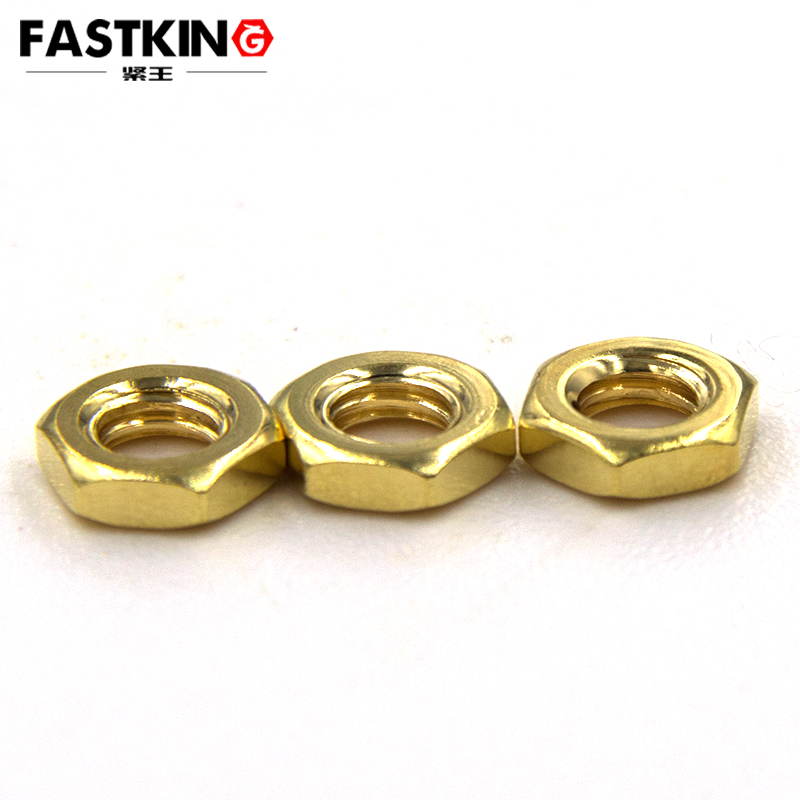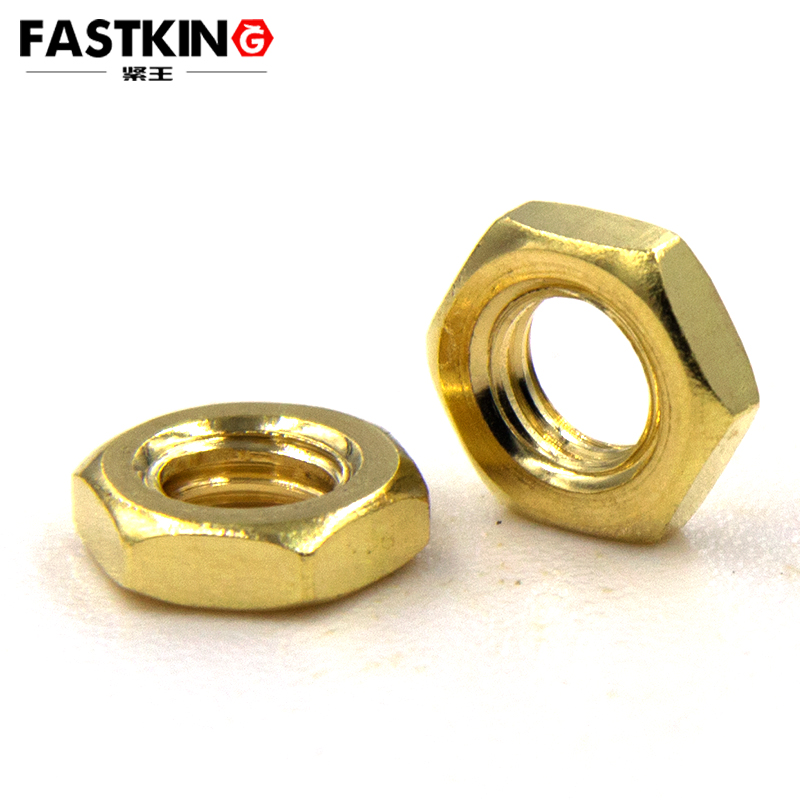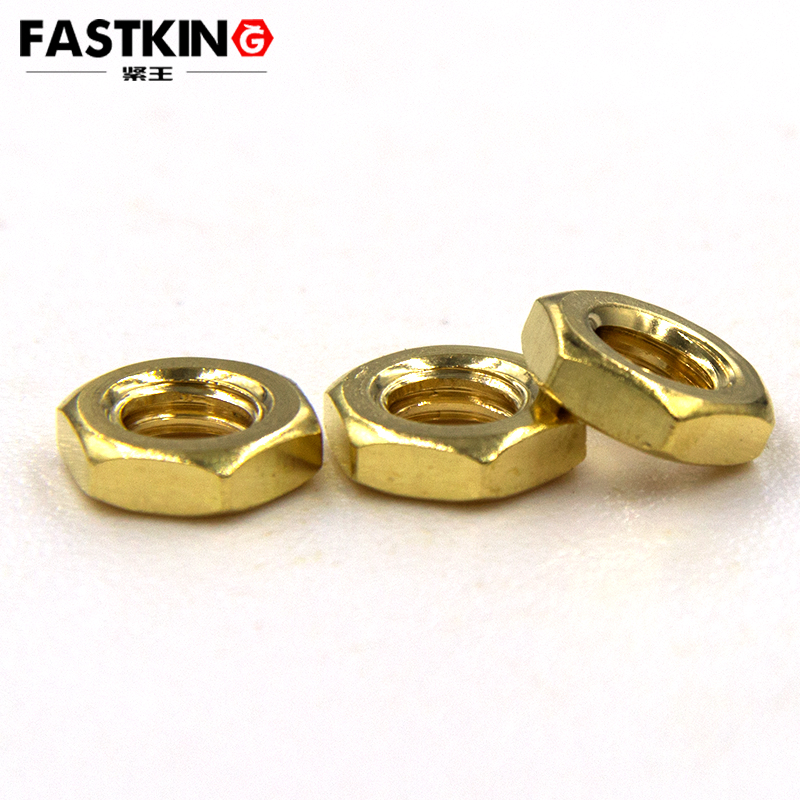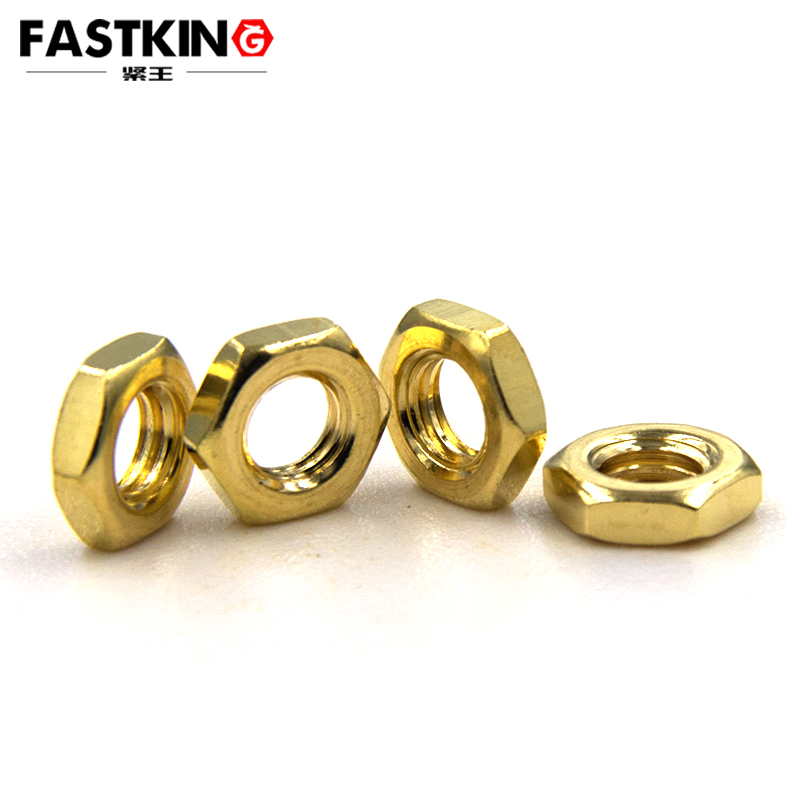Brass hex thin nuts are common mechanical fasteners made from brass material, featuring a hexagonal shape with a thinner profile compared to standard nuts. These nuts combine the excellent properties of brass material with the advantages of thin design, playing significant roles across various industrial fields and daily applications.
Manufactured from brass alloys (such as H59, H62), these nuts offer superior corrosion resistance, electrical/thermal conductivity, and machinability. Unlike ordinary steel nuts, brass hex thin nuts don't rust, making them particularly suitable for humid environments or applications requiring avoidance of magnetic interference. Their hexagonal shape allows easy installation and removal using standard wrenches or sockets, while the thin profile makes them especially useful in space-constrained situations.

II. Primary Application Scenarios for Brass Hex Thin Nuts
Electronics and Electrical Applications
In the electrical and electronics field, brass hex thin nuts are widely favored for their non-magnetic properties and good conductivity:
- PCB mounting: Thin design prevents excessive vertical space occupation when securing circuit boards to chassis or brackets
- Electrical equipment assembly: Internal fastening for transformers, relays and other devices where magnetic interference must be avoided
- Communication equipment: Base station equipment, antenna mounting where brass's weather resistance ensures long-term stability
- Instruments: Enclosure fastening for precision instruments where thin nuts reduce overall volume and weight
Pipeline Connections and Fluid Systems
Brass's excellent corrosion resistance makes it ideal for fluid handling systems:
- Plumbing systems: Water heater, valve, and pipe connections resistant to scale and corrosion
- Chemical equipment: Connections for chemical piping in non-strong acid/alkali environments
- Gas equipment: Gas meter connections, pipe interfaces requiring explosion-proof and corrosion-resistant properties
- Refrigeration systems: Pipeline connections for air conditioners, refrigerators and other cooling equipment
Decorative and Architectural Applications
Brass's natural color and oxidation resistance provide unique advantages in decorative applications:
- High-end furniture assembly: Particularly for retro styles or designs where hardware is meant to be visible
- Architectural decoration: Curtain wall systems, decorative trim fastening combining functionality and aesthetics
- Bathroom fixtures: Installation in humid environments for faucets, shower enclosures
- Lighting fixtures: Especially for lighting equipment requiring conductive grounding
Automotive and Transportation
Certain automotive applications utilize brass hex thin nuts:
- Electrical system connections: Battery terminals, wiring harness fastening
- Interior fastening: Used in space-limited areas
- Marine applications: Corrosion-resistant fastening for onboard equipment
Machinery and Special Environments
- Food processing equipment: Complies with hygiene requirements, resists bacterial growth
- Medical devices: Non-magnetic environments for medical instruments
- High-temperature environments: Maintains performance at moderately high temperatures
- Vacuum equipment: Avoids magnetic interference in vacuum environments
III. Proper Usage Methods for Brass Hex Thin Nuts

Pre-installation Preparation
Size matching: Verify nut thread specifications (M3, M4, M6 etc.) match the bolt perfectly
Surface inspection: Check for thread damage or foreign objects on both nut and bolt
Cleaning: Remove dust or metal chips from threads using a brush, apply thread cleaner if necessary
Lubrication: Apply small amount of brass-specific anti-seize compound in high-temperature or corrosive environments
Tool Selection
Manual tools: Choose correctly sized open-end wrenches, box wrenches or socket wrenches
Power tools: Use torque-controlled electric drivers with appropriate torque settings
Special tools: Thin-profile sockets for space-constrained areas
Table: Wrench Sizes for Common Brass Hex Thin Nuts
| Nut Size | Across Flats (S Dimension) | Recommended Wrench Size |
|---------|----------------|------------|
| M3 | 5.5mm | 5.5mm |
| M4 | 7mm | 7mm |
| M5 | 8mm | 8mm |
| M6 | 10mm | 10mm |
| M8 | 13mm | 13mm |
Detailed Installation Steps
Hand tightening: Start threading nut by hand for several turns to ensure proper thread engagement
Initial tool tightening: Use wrench to rotate nut until contacting the fastened surface
Final tightening: Apply appropriate torque (typically 20% less than for steel nuts)
Torque control: For critical connections, use torque wrench with these reference values:
Table: Recommended Tightening Torque for Brass Hex Thin Nuts (Nm)
| Nut Size | General Torque | Critical Connection Torque |
|---------|-------------|-------------|
| M3 | 0.5-0.8 | 0.8-1.2 |
| M4 | 1.2-1.8 | 1.8-2.5 |
| M5 | 2.0-3.0 | 3.0-4.0 |
| M6 | 4.0-5.0 | 5.0-7.0 |
| M8 | 8.0-10.0 | 10.0-12.0 |
Anti-loosening: Consider using lock washers or thread locker in vibrating environments
Usage Precautions

Avoid overtightening: Brass has lower strength than steel; excessive force may strip threads or crack nuts
Temperature considerations: Continuous working temperature shouldn't exceed 200°C to prevent strength reduction
Material compatibility: Avoid direct contact with aluminum, zinc etc. to prevent galvanic corrosion
Reuse: Brass nuts can typically be reused 2-3 times, but critical applications should use new nuts each time
Removal techniques: For seized nuts, apply penetrating oil first rather than using excessive force
Maintenance and Inspection
Regular inspection: Check fastening condition every 6-12 months in humid/corrosive environments
Surface treatment: Use brass-specific cleaners to maintain appearance and performance
Replacement criteria: Replace immediately if threads are damaged, cracked or significantly deformed
Advantages and Disadvantages Analysis
Advantages:
Excellent corrosion resistance for humid/chemical environments
Non-magnetic properties won't affect sensitive electronics
Good electrical and thermal conductivity
Natural antibacterial properties suitable for hygienic applications
Attractive golden color for decorative uses
Space-saving thin design
Disadvantages:
Lower mechanical strength than steel nuts, unsuitable for high-load applications
Higher cost than standard carbon steel nuts
Performance degrades in high-temperature environments
Potential galvanic corrosion with certain metals
Selection Recommendations

Size selection: Choose appropriate thinness based on connected parts' thickness (typically 50% of standard nut thickness)
Material selection: H62 brass suits most applications; special alloys like silicon brass for extreme conditions
Surface treatment: Generally maintain natural brass color; nickel or chrome plating for special needs
Matching bolts: Recommend using same-material brass bolts or stainless steel bolts; avoid mixing with carbon steel bolts
Conclusion
Brass hex thin nuts play irreplaceable roles across multiple industries including electronics, piping, and architectural decoration due to their unique material properties and structural characteristics. Proper selection and usage not only ensure connection reliability but also maximize brass's various advantages. Users must pay special attention to their strength limitations, avoiding overtightening. When used appropriately with correct installation methods, brass hex thin nuts provide long-lasting, stable fastening performance. As industrial technology advances, these nuts will continue expanding their applications, offering elegant solutions for fastening needs in various specialized environments.
